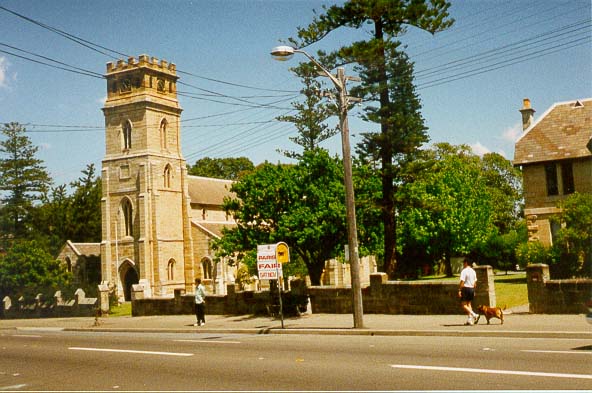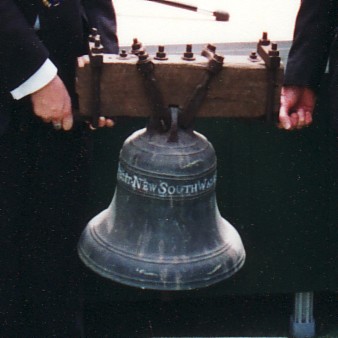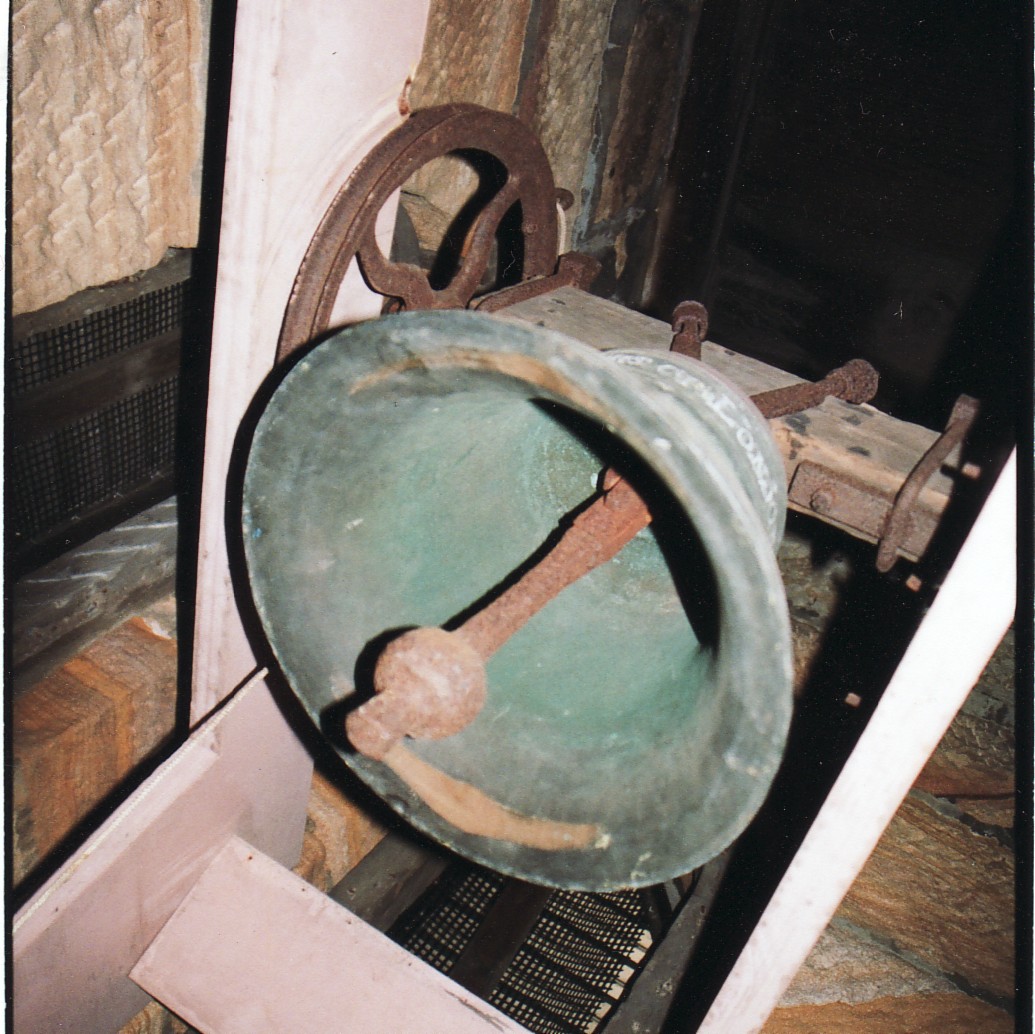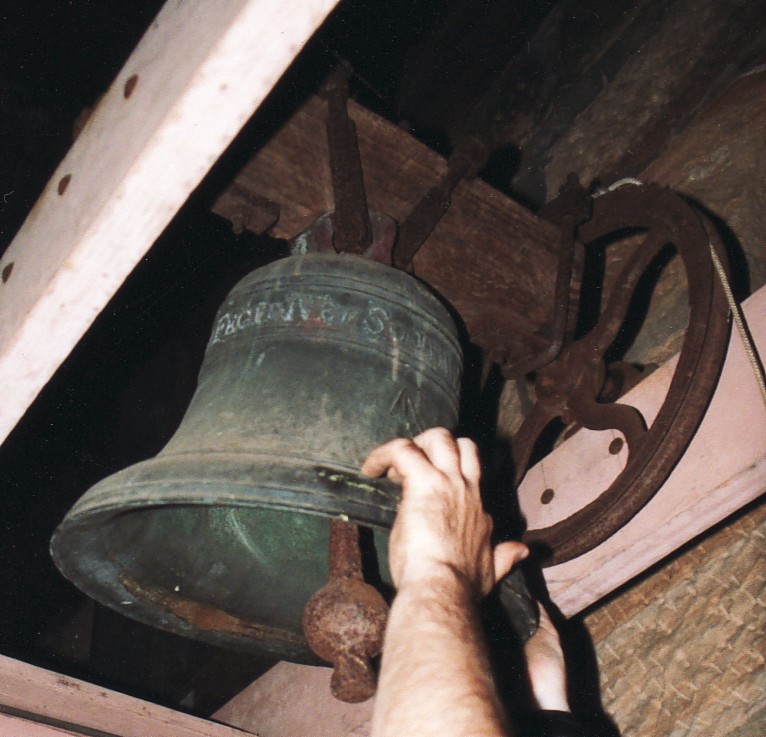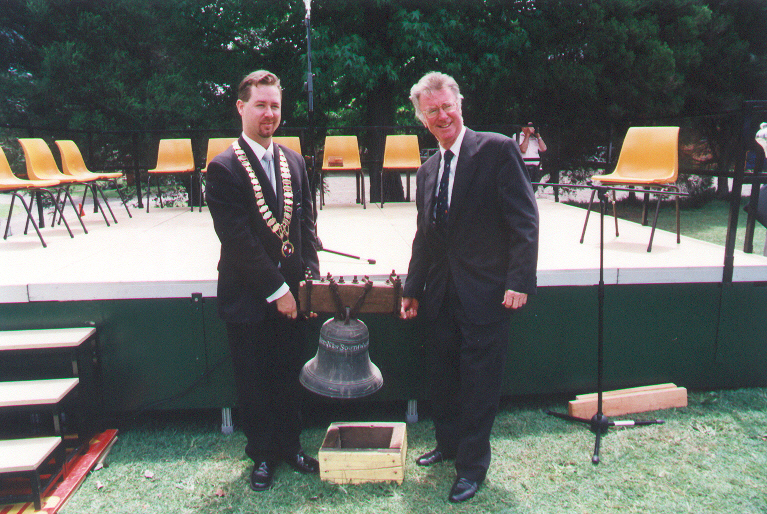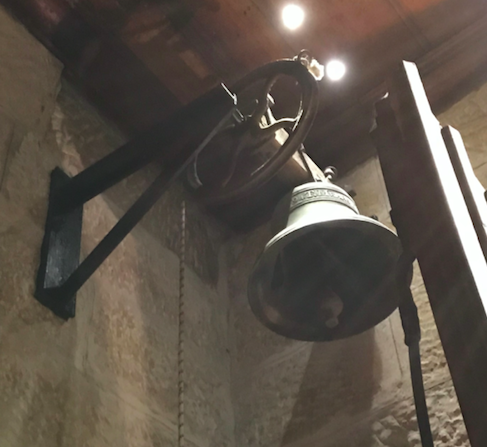By Peter Alexander
On Sunday, 19 February 1995, a group of St Jude’s parishioners were talking about the history of the parish. One of them, Dionne Knox, mentioned some research in the archives of the Randwick Historical Society, to a set of eight bells, the oldest in Australia, having been brought to Sydney in 1807. Most of them had disappeared by the middle of the nineteenth century, but — and this was the point — one was said to have been given to St Jude’s Church, Randwick, for use in the parish school.
There was a good deal of interested discussion about this information. Bells are almost indestructible, unless deliberately melted down or smashed: and St Jude’s, having secured such a treasure, was not likely to have lost it. Where could the old bell be? We knew it wasn’t in the building which had been used as the parish school. The obvious place was the bell-tower, but we believed all the bells in there were made of steel and had been installed well on in the nineteenth century.
‘What about the service bell?’, said someone. This is the single bell rung from the ground floor of the tower, to announce the imminent beginning of a service. Then several voices said together, ‘Let’s go up the tower and see.
A torch was found from the rectory, and an expedition set off up the tower in excitement and trepidation. The trepidation was justified: St Jude’s tower, like much of the rest of the church fabric, is in great need of repair — repair which it’s now getting, for the Parish Council has authorised the expenditure of around $20,000 a year each year into the future to ensure the church is got back into sound order. The tower is one of the first areas to be repaired, but as the ‘expedition’ made its way up increasingly gloomy and steep stairways that soon became near-vertical shaky ladders leading up into shadow, signs of the urgent need for attention from the stonemasons were everywhere to be seen. The stonework is literally crumbling into sand, which forms little drifts in every dark corner. The Council’s move to get the repairs going has come none too soon.
Up we went, led by Ian Knox into darkness that by now was inky, and at last reached our goal. In the belfry, in the topmost floor of the tower, hanging among the great steel bells of the church peal, was a quite different bell, green with age. It was comparatively small, and even in the feeble light of the torch it could clearly be seen to be bell-metal, not steel. And running around its side was lettering. With mounting excitement, half by torchlight and half by feel, we spelled it out: ‘T. MEARS & SONS WHITECHAPEL LONDON FECIT “(Latin for ‘made me’). And round the other side of the bell, against the tower wall, ‘NEW SOUTH WALES 1794’. This was it all right, the oldest bell in Australia, and the inscription proved it had been cast specially for New South Wales, only six years after the first white settlement!
One of the expeditioners, Heather Barrett, is a librarian, and over the next week she continued research into the history of this extraordinary find. And the bell turned out to have a fascinating background.
The King in 1794 was George III, known as ‘Farmer George’ for his interest in ploughing and cattle-breeding, and he was already showing signs of the mental instability that would soon become madness. His son, the Prince of Wales, would take over as Prince Regent in 1811 and would succeed to the throne as George IV in 1820.
It was George III who, on hearing that a church had been built in his new colony of New South Wales, ordered that a set of eight bells be cast for it. They were small enough to transport easily by sea, and they were a set intended for playing tunes. And it was the Duke of Clarence (the future King William IV, and uncle of Queen Victoria) who made the presentation to Governor Hunter before he left for Australia in 1795, taking with him the bells to be hung in the tower of the new church, St Phillip’s in Sydney. For reasons that remain mysterious, 13 years passed between the casting of the bells and their first installation in the old round tower of St Phillip’s. In fact, the bells appear to have been lost, because Governor Bligh is recorded as having ‘found’ them in 1807.
In an article entitled ‘Old Church of Saint Phillip’ there is the following brief account reporting the President of the Royal Australian Historical Society as saying, in 1942:
Governor Hunter had brought with him from England a peal of eight small bells. They were found by Governor Bligh, who had them hung in the church tower. They were rung for the first time on Friday, May 29, 1807. Two of these bells were preserved in the Museum of the Royal Australian Historical Society, whilst a third was in St Jude’s Church, Randwick.[1]
The President of the Historical Society was probably drawing for his information on the Sydney Gazette and New South Wales Advertiser of Sunday, 7 June 1807, which reports that St Phillip’s church tower had been completed on 29 May 1807, and that ‘Eight bells are hung in the upper floor, which were rung that day.’ The same issue of the Sydney Gazette and New South Wales Advertiser reported that on Thursday, 4 June 1807, ‘His Majesty’s birthday’, the bells rang successive peals during the day. And it added, ‘These old bells were made by T. Meares, of London, in 1794.’ So the bell at St Jude’s was being called ‘old’ as far back as 1807!
But when and how did it make the move from St Phillip’s round tower to St Jude’s square one? When in doubt, suspect Simeon Pearce, the shrewd property developer who was St Jude’s great and founding patron and who named Randwick after his native village in Gloucestershire. On 3 April 1916, a Sydney magazine called The Truth (long since defunct) carried an letter from a campanologist who called himself ‘Treble Bob’, and who had obviously known Simeon Pearce and talked to him about the bell:
Dear Old Chum, About the year 1807, the King presented to the ‘settlement of Sydney’ a peal of eight small bells, and they were hung in old St. Philip’s round church tower. The late S. H. Pearce, of Randwick, lived in St Philip’s parish about 1843, and he stated that he found three of these bells then remaining in the tower, and chimed them on several occasions. He also stated that Mr McRoberts, who had then been church clerk and schoolmaster for thirty years, told him that the other five bells were taken by the Government for various public purposes. It seems such a pity that the first church bells in Australia should have thus been lost sight of. We know that one of them was presented by the late John Campbell to St Jude’s School, at Randwick, where it still hangs. One other was used on the old light ship Bramble, and is now at the offices of the Harbour Trust. The remaining six may possibly still be in existence, and I am hopeful that some of your numerous readers may be able to throw some light on the subject.
None did. But a little more light is shed on the St Jude’s bell by a paper read to the Royal Australian Historical Society on 28 July 1914 by the historian A. B. Joyner:
The first peal of bells in Australia was presented to the settlement by the Duke of Clarence, afterwards King William IV. These were hung in the round tower of the original St. Phillip’s Church at Church Hill. They numbered eight, and although but small in size, it is said that the peal was harmonious. They were intended for playing tunes.
In the year 1843 the late Mr S. H. Pearce of Randwick resided in St. Phillip’s Parish, and he found eight bell frames in the old bell tower, but only three bells, the Government having taking [sic] away five for public purposes. As one of the three bells only was required for the Church, the late Hon. J. Campbell gave one of the others to St. Jude’s School, at Randwick, in 1858, where it still hangs, but so rusted in its bearings, that it cannot be used.[2]
So it was Simeon Pearce, always keenly on the lookout for anything that would benefit St Jude’s, who had persuaded the wardens of old St Phillip’s to donate the bell to St Jude’s.
Well, Pearce’s gift is still in the tower of the church he loved, and no longer ‘so rusted in its bearings that it cannot be used’. On the contrary, its voice is heard every Sunday by all within earshot of St Jude’s. Indeed, in January 1988, when churches all over Australia rang their bells at sunrise to welcome in the nation’s Bicentennial year, the church chosen to begin that great east-to-west movement of sound across the continent was St Jude’s. And it was entirely appropriate that the bell that first announced the Bicentennial dawn was the oldest in Australia.
[1] In Royal Australian Historical Society Vol 28, Pt 1. 1942. p 56.
[2] A. B. Joyner, “Church Bells”, in, Royal Australian Historical Society, Vol 3, Pt7, 1916, pp.352ff (read before the Society, July 28, 1914).
Peter Alexander 1949-2014 – Emeritus Professor of English at the University of NSW (UNSW). As well as having a major international reputation as a literary biographer, Peter played an active role in the life and business of UNSW. He was a thoughtful, challenging and much admired teacher and mentor.
Postsccript 1:
“In the tower is a smaller bell, used until recently as a service bell. When taken down for repairs some years ago it was found to be a link with the colony’s early days. It is marked “T. Mears & Sons, Whitechapel, London 1794” on one side and “New South Wales” on the other. It is one of the small peal donated by the Duke of Gloucester to the old St. Phillips. When that tower was demolished the bells were given to other churches”.
Excerpt from F.A. Doyle’s talk entitled “St Jude’s Precinct”, 16th July 1988.
Postscript 2:
Peter Alexander’s article was written five years before the 2000-2001 Randwick Bell Project, when the old steel bells were replaced with new bronze bells. The Old Bell took centre stage at the Welcoming of the Bells Ceremony in 2001. One of the photos of the bell inserted here shows the bell held by the Mayor of Randwick at the time, Dominic Sullivan (left) and the then State Member for Coogee, Ernie Page (right).
